This post may contain affiliate links. Please read our disclosure policy.
Taiwanese beef noodle soup is a cozy and flavorful dish that’s often called the national dish of Taiwan. With tender beef, chewy noodles, and a rich, spiced broth, it’s a bowl of comfort that brings families together. It might look fancy, but it’s surprisingly simple to make at home with just a few key steps.
Coming from a Taiwanese family, this dish holds a special place in my heart. This recipe is inspired by the classic red-braised style, perfect for a chilly evening or whenever you’re craving something warm, hearty, and deeply authentic to Taiwanese cooking!
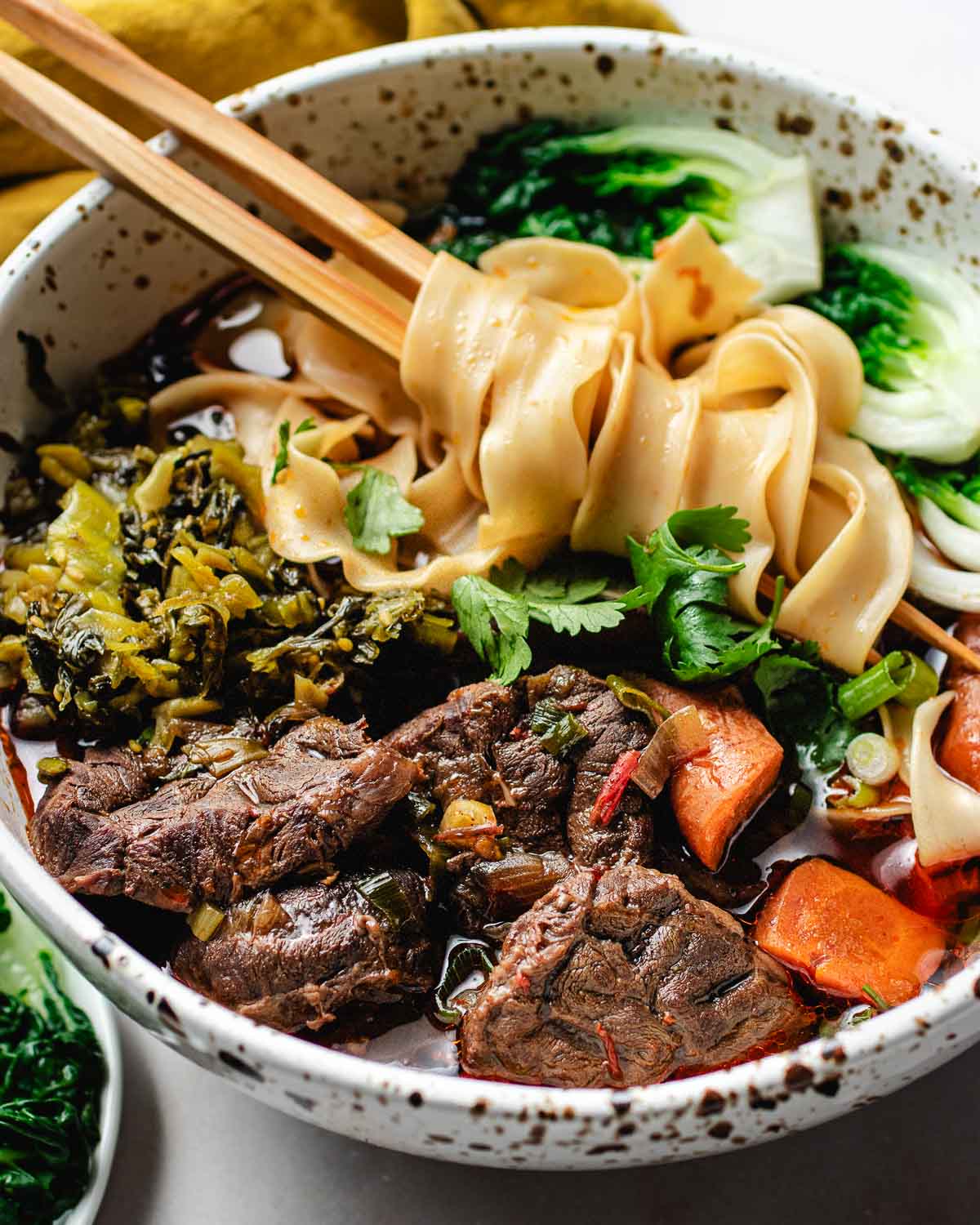
Table of Contents
- What is Taiwan beef noodle soup
- Key Ingredient highlights
- 1. Beef shank (boneless)
- 2. Doubanjiang
- 3. Chinese dried chilies, star anise pods, and five spice powder
- 4. Taiwanese michu
- 5. Taiwnaese style sliced noodles
- How to make braised beef noodle soup
- ChihYu’s tips for success
- More Taiwanese recipes you might like
- Taiwanese beef noodle soup recipe
What is Taiwan beef noodle soup
Taiwanese beef noodle soup (niu rou mian) is often called the national dish of Taiwan. It’s made with tender boneless beef shank, chewy noodles, and a rich, flavorful beef broth infused with warming spices like star anise and cinnamon. The soup is savory, with a hint of sweetness that makes it deeply comforting.
Taiwanese braised beef noodle soup comes in two styles: red-braised (hong shao niu rou mian 紅燒牛肉麵), made with soy sauce for a darker, richer broth, and a clear broth version (清燉牛肉麵), which skips the soy sauce for a lighter flavor. Every Taiwanese family has their own way of making it—some add tomatoes for tanginess, others tweak the spice levels—but the heart of the dish stays the same.
In Taiwan, you can smell its aroma even at the airport shops! It’s a beloved dish you’ll find everywhere, from night markets to noodle shops on nearly every street corner. It’s more than just a bowl of noodles; it’s a true celebration of Taiwanese heritage and the pride we pour into every bite.
Key Ingredient highlights
Here’s everything you need to make the best braised beef noodle soup! For the full recipe, check the recipe card at the end of the post. Most of these ingredients are easy to find in major grocery stores or online, and we’ve included tips on where to buy them.

1. Beef shank (boneless)
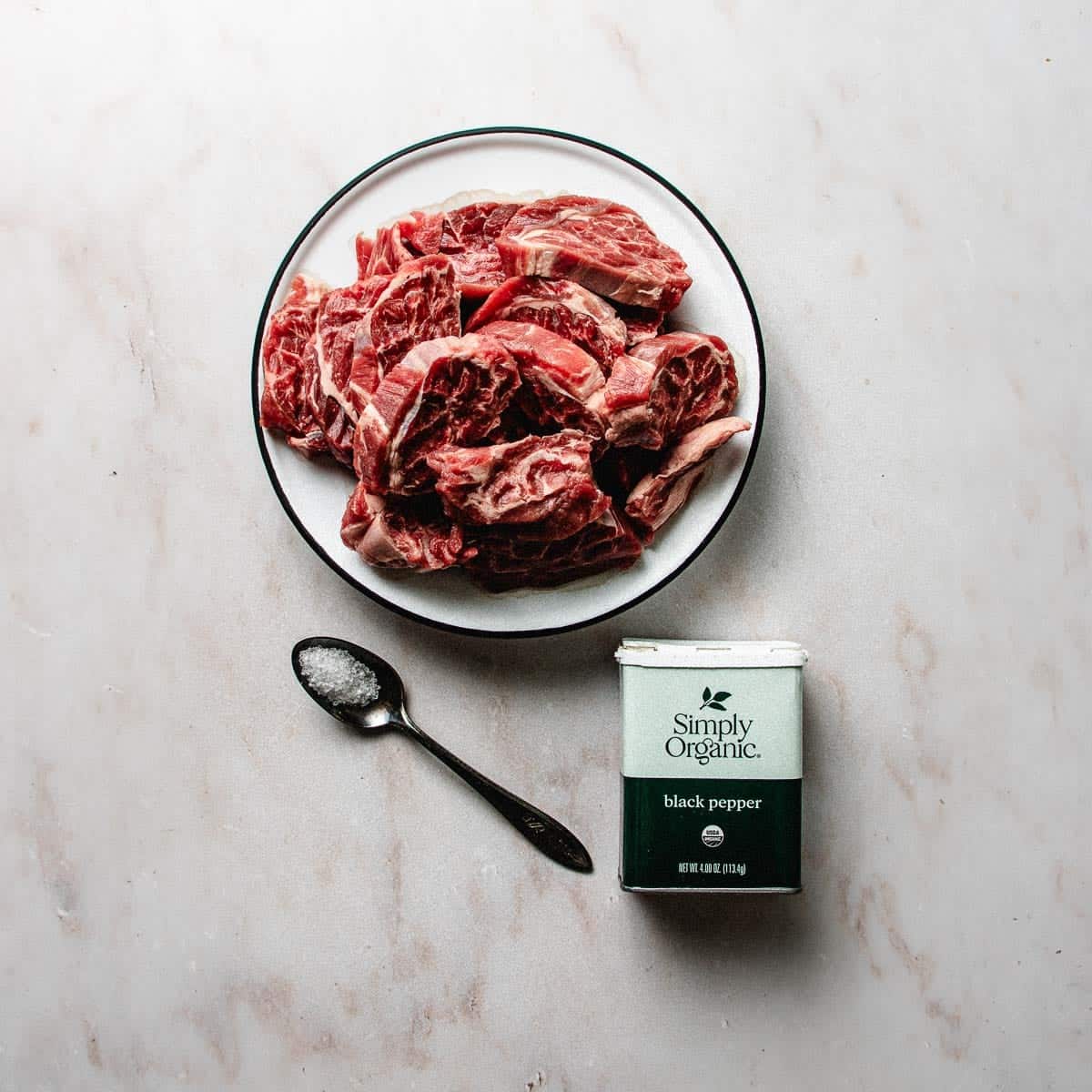
Beef shank used in Asian beef noodle soup is butchered lengthwise into one chunky strip (whereas Western-style shank is sliced crosswise and often includes bones). It’s a lean, tougher cut but rich in connective tissue and collagen, which break down during slow cooking to create a tender, melt-in-your-mouth texture. It also adds a natural gelatinous quality to the broth.
- Substitute: Boneless chuck roast or beef stew meat for similar tenderness.
2. Doubanjiang
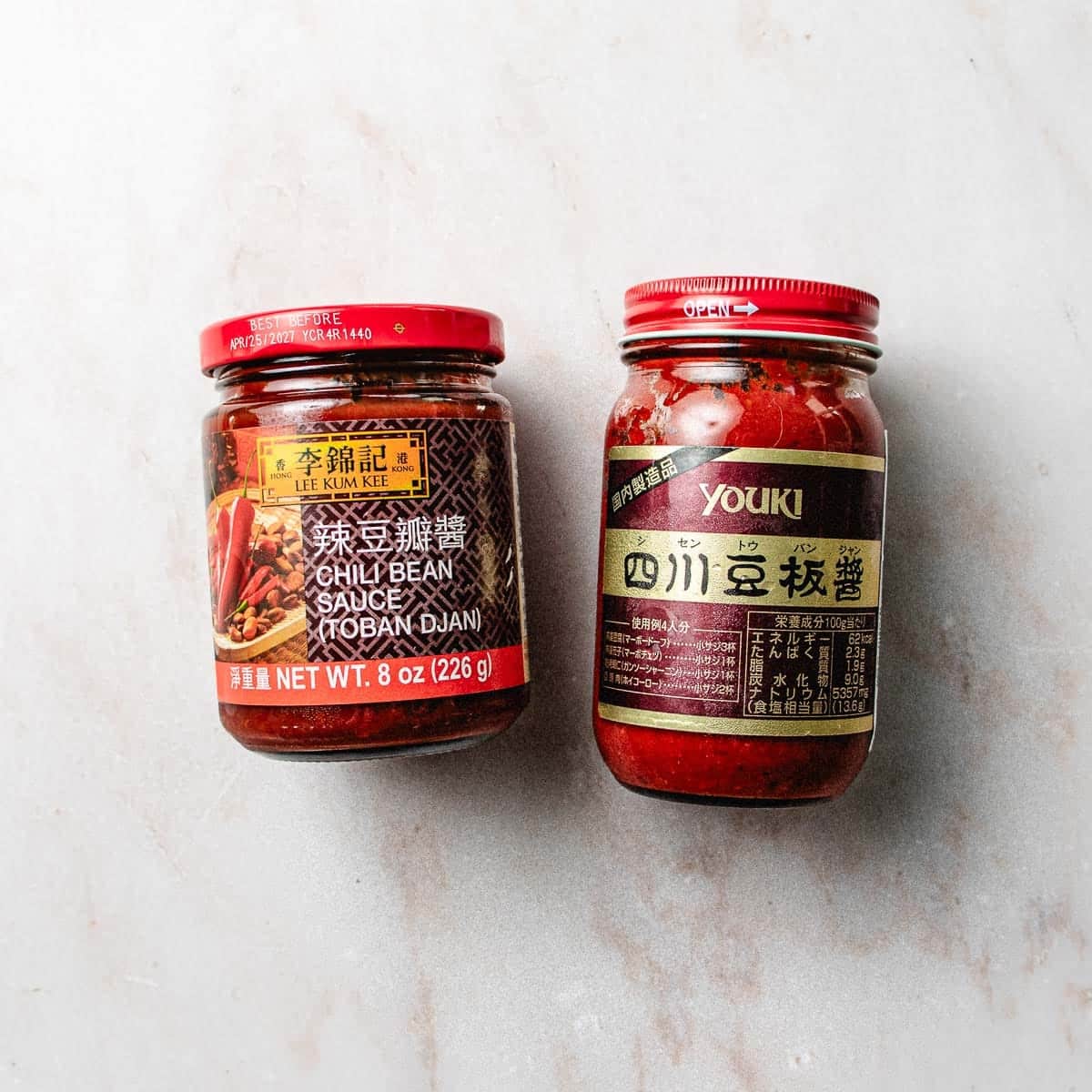
Doubanjiang is a savory, spicy, and slightly funky paste made with fermented broad beans, soybeans, chili peppers, and salt. It’s a must-have for authentic braised beef noodle soup.
Types of Doubanjiang:
- Milder Doubanjiang: Labeled sweet or mild, with minimal heat and more umami.
- Extra Spicy Doubanjiang: Often labeled Sichuan-style, known for its fiery kick.
- Aged Doubanjiang: Rich and smoky, with deeper flavors from long fermentation.
For this recipe, I use mild doubanjiang from Lee Kum Kee, which is less salty and not as spicy. Keep in mind, spice and salt levels vary by brand. For example, the gluten-free version from Yuki Sichuan (pictured above) is much spicier and saltier. Adjust accordingly!
3. Chinese dried chilies, star anise pods, and five spice powder
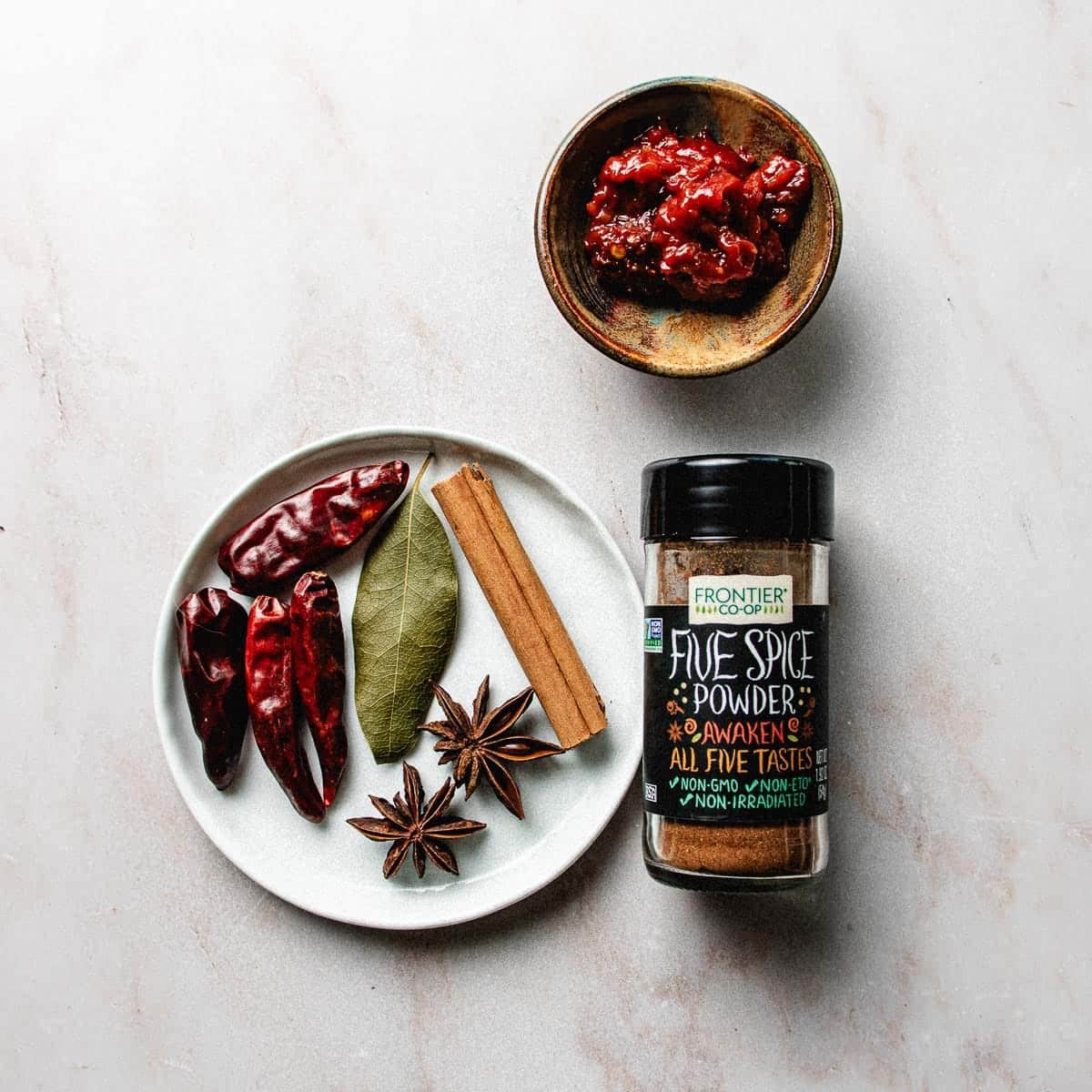
- Chinese dried chilies: Used whole, these chilies soften as they simmer in the broth, adding a subtle spicy fragrance without overpowering the dish.
- Five spice powder: A blend of star anise, cloves, cinnamon, fennel seeds, and Sichuan peppercorns. It’s widely available in Western grocery stores.
- Star anise pods (optional): Adds a licorice-like sweetness to deepen the broth flavor. A little goes a long way—1 to 2 small pods are enough. Since we’re also using five spice powder, this ingredient is optional.
4. Taiwanese michu
Taiwanese michu (rice cooking wine) is made from fermented glutinous rice, containing rice, water, and a small amount of alcohol. It has a mild, slightly sweet flavor that enhances the depth and aroma of broths, marinades, and stir-fries without overpowering the dish.
- Substitute: Chinese cooking wine, dry sherry, or sake for a similar effect.
5. Taiwnaese style sliced noodles
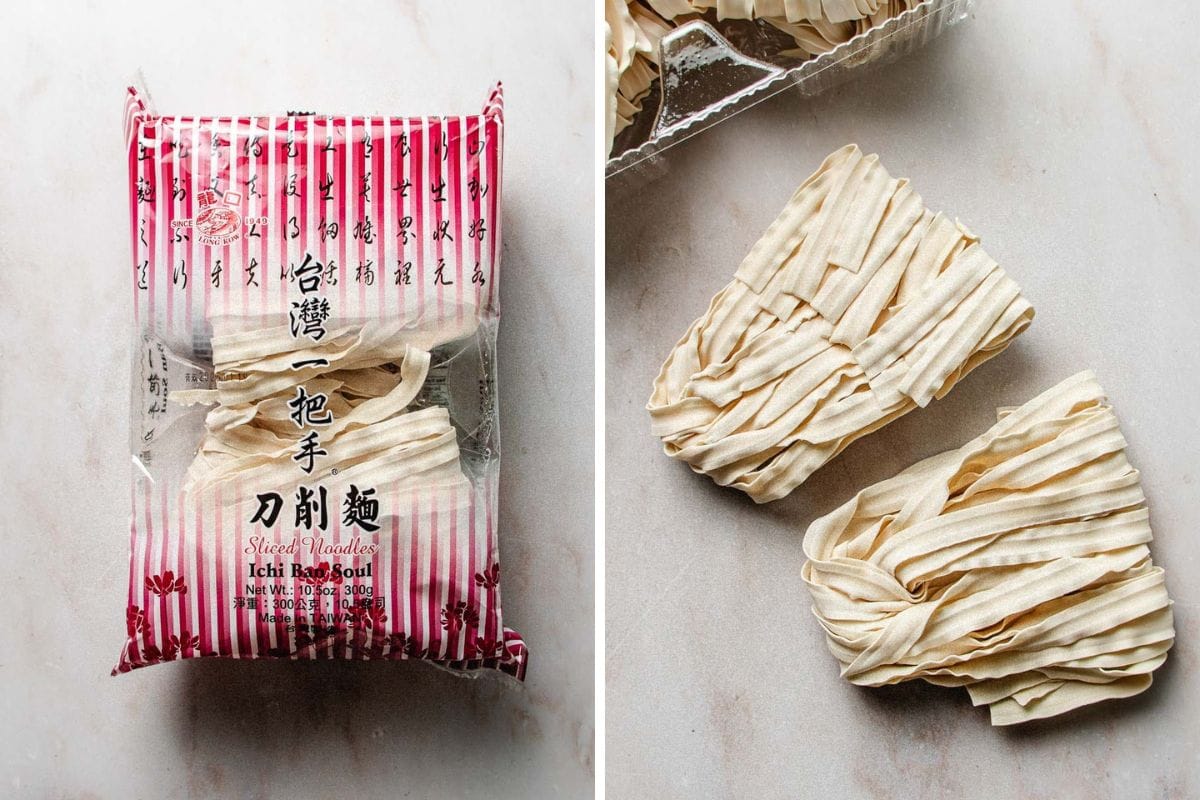
For an authentic taste, wheat noodles are the most traditional choice, especially hand-pulled noodles (la mian) or sliced noodles (dao xiao mian).
- Substitute: Rice noodles, vermicelli, or gluten-free noodles. See my Chinese noodle guide for more options.
How to make braised beef noodle soup
Cooking Taiwanese beef noodle soup might seem complex, but it’s actually straightforward and approachable. This dish is a staple in Taiwanese homes for a reason—it’s simple, hearty, and packed with flavor. Follow these easy steps, and you’ll see why it’s a national favorite!
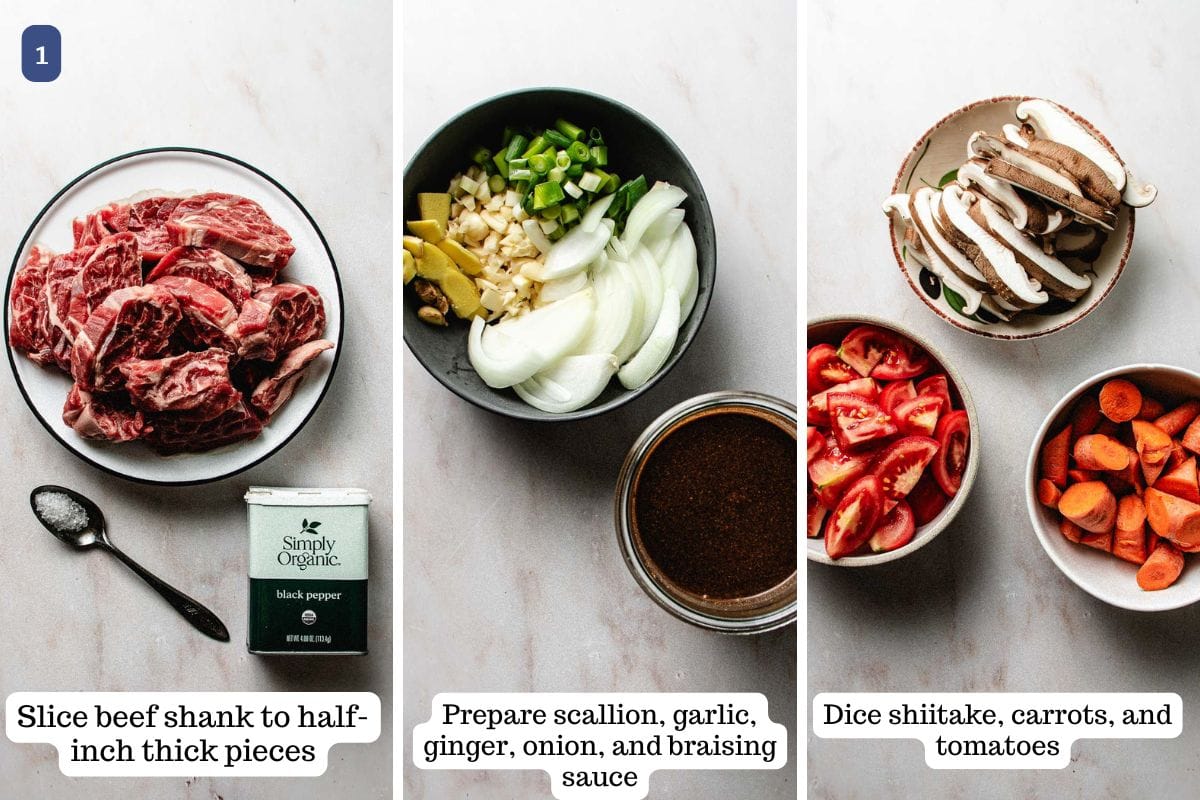
- Prep ingredients: Slice onion, garlic, ginger, and chilies. Chop scallions (separate white and green parts), dice tomatoes and carrots, and slice shiitake mushrooms. Slice beef into slightly thicker than ½-inch pieces, season with salt and pepper. Mix all braising liquid ingredients in a 2.5-cup container and stir to dissolve sugar.
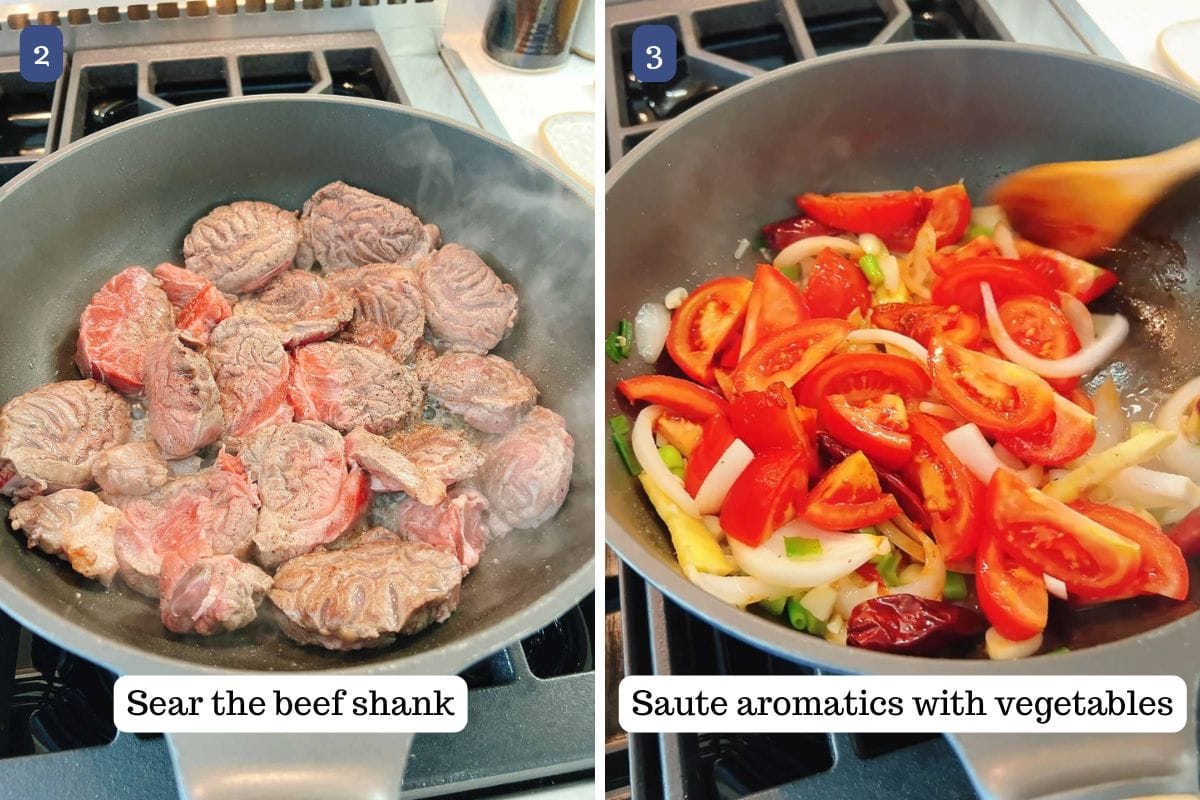
- Sear the beef: Heat a large sauté pan with oil over medium heat until hot. Increase to medium-high, sear beef for 2 minutes on one side and 1 minute on the other. Set aside.
- Sauté aromatics: In the same pan, sauté onion, garlic, ginger, chilies, and white scallion parts over medium-high heat for 3 minutes. Add tomatoes and doubanjiang, and sauté for another 2 minutes. Turn off heat.
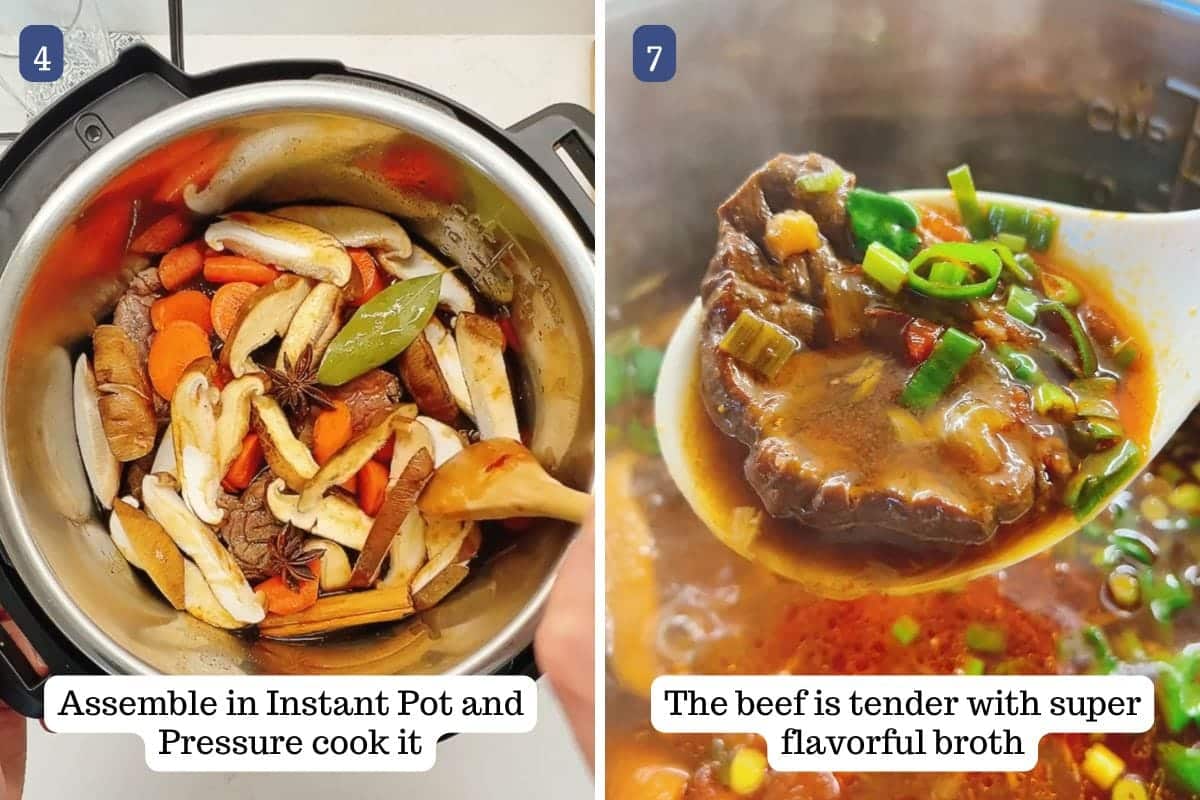
- Assemble in the Instant Pot: Transfer the sautéed aromatics, beef, carrots, shiitake mushrooms, cinnamon stick, bay leaf, and star anise (if using) into the pot. Stir the braising liquid again and pour it evenly over the ingredients.
- Pressure cook: Seal the lid and pressure valve. Cook on Manual – High Pressure for 40 minutes. Allow a natural release for 15 minutes, then carefully switch to quick release.
- Blanch vegetables and cook noodles: Blanch bok choy or spinach in boiling water for a few seconds, then set aside. Use the same water to boil noodles according to package instructions.
- Adjust the broth: Taste the broth—it will be concentrated. Dilute with 1.5 to 2.5 cups of hot water if needed to lighten the flavor.
- Serve: Divide noodles into bowls. Ladle beef, broth, and vegetables over the noodles. Garnish with cilantro and serve with pickled mustard greens, if desired.
* See my recipe card at the end of the post for the stovetop method.
Good to know
Beef shank tender tip!
For tender, melt-in-your-mouth beef shank, slice it slightly thicker than ½ inch (1.3 cm) and braise it slowly to break down the collagen.
Some recipes recommend hot water blanching sliced beef shank to remove impurities. This extra step is crucial if you’re making the clear broth version of niu rou mian (i.e. without the soy sauce). For red-braised soup, like this recipe, blanching is less crucial—a quick stir-fry locks in flavor and enriches the broth!
ChihYu’s tips for success
- Choosing the Right Beef Shank: Use boneless Asian-style beef shank, which is butchered lengthwise into a chunky strip. This cut is ideal for its rich connective tissue that breaks down beautifully during cooking. Look for it in Asian grocery stores or ask your butcher for boneless shank or shin meat.
- Slicing the Beef: Slice the beef slightly thicker than ½ inch (1.3 cm) to help it stay tender and juicy during slow cooking. The connective tissue will create melt-in-your-mouth bites.
- Doubanjiang Matters: Stir-fry the doubanjiang with aromatics to unlock its full flavor. If using a spicier or saltier brand, like Yuki Sichuan brand, reduce the amount to 2-3 teaspoons to balance the broth.
- Control the Broth’s Flavor: The broth will be concentrated after cooking. Taste and dilute with 1.5 to 2.5 cups (360–600 ml) of hot water if needed to adjust the flavor to your liking.
- Noodles and Timing: Boil the noodles just before serving so they stay fresh and chewy. Blanch vegetables in the same pot to save time, and time it well to serve everything warm together.
More Taiwanese recipes you might like
Curious about other Taiwanese dishes? Here are more comforting and flavorful recipes I love, perfect for bringing a taste of Taiwan to your table.
- Taiwanese Beef Stew: A hearty stew made with bone-in beef shank and root vegetables, simmered until tender in a flavorful broth.
- Taiwanese Popcorn Chicken: A night market favorite featuring super crispy, golden bites of seasoned chicken—irresistibly crunchy!
- Taiwanese Braised Minced Pork and Rice: Savory minced pork simmered in a rich soy-based sauce, served over fluffy white rice.
- Sha Cha Beef: A stir-fry classic with tender beef slices coated in homemade sha cha sauce, bursting with smoky, umami flavors.
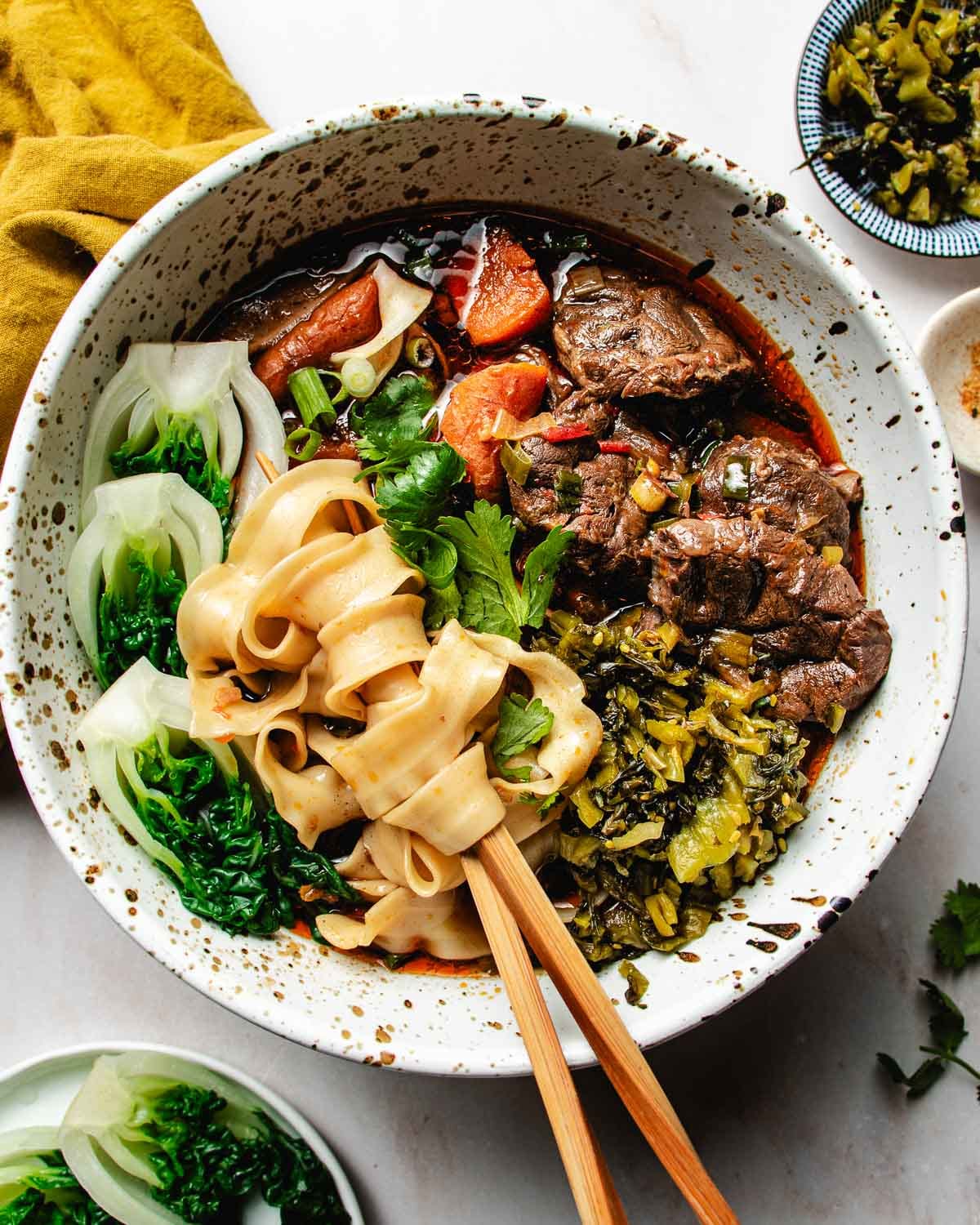
Taiwanese beef noodle soup recipe
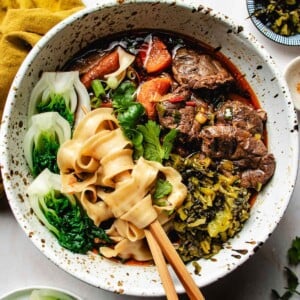
Video
Ingredients
Aromatics and vegetables:
- 4.3 oz yellow onion sliced (half of one large)
- 10 oz garlic cloves roughly chopped, 10 large
- 0.5 oz ginger sliced (4-5 pieces)
- 4 whole Chinese dried chilies or 2 large serrano/fresno chilies, seeds removed
- 4 bulb scallion chopped (separate white and green parts)
- 4 whole vine tomatoes roughly sliced (14.5 oz)
- 8.6 oz loose carrots diced into 1 ½-inch chunks (3 medium)
- 4-5 oz fresh shiitake sliced (4-5 full-sized caps)
Beef:
- 2 lbs boneless beef shank or substitute boneless chuck roast or beef stew meat
- ½ tsp coarse sea salt divided
- ½ tsp ground black pepper divided
Seasonings:
- 1 tbsp avocado oil
- 2 tbsp doubanjiang see notes
- 1 whole cinnamon stick 3-inch
- 1 piece dry bay leaf
- 2 piece star anise pods optional
Braising liquid:
- 1 cup beef stock e.g., Pacific Foods
- ½ cup water
- ½ cup soy sauce
- ½ cup Taiwanese michu or Chinese cooking wine
- 1 tsp coarse sea salt or more to taste
- 2 tsp five spice powder
- 2 tbsp brown sugar or rock sugar
Serving:
- Blanched vegetables e.g., bok choy or baby spinach
- Taiwanese Sliced Noodles (Dao xiao mian) e.g., wheat-based noodles or la mian
- Garnish Cilantro leaves optional
- Chinese pickled mustard greens optional
Instructions
Prep:
- Prepare aromatics and vegetables: Slice the onion, garlic, ginger, and chili peppers. Chop the scallions, separating the white and green parts. Dice the tomatoes, carrots, and slice the shiitake mushrooms.
- Slice and season beef: Slice beef into slightly thicker than ½ inch (1.3 cm) slices. Season with ¼ tsp each of salt and pepper.
- Prepare braising liquid: In a cup or bowl (at least 600 ml capacity), combine beef stock, water, soy sauce, michu, salt, five spice powder, and sugar. Stir well to dissolve the sugar.
Sear beef:
- Heat a large sauté pan over medium heat until hot. Add avocado oil.
- Increase heat to medium-high and sear beef for 2 minutes on one side, then 1 minute on the other. Remove and set aside.
Saute aromatics and tomatoes:
- In the same pan, sauté onion, garlic, ginger, chili peppers, and white scallion parts over medium-high heat for 3 minutes.
- Add tomatoes and doubanjiang. Sauté for 2 minutes, then turn off the heat.
Transfer to instant pot:
- Transfer sautéed aromatics, tomatoes, and beef into the Instant Pot.
- Add carrots, shiitake mushrooms, cinnamon stick, bay leaf, and star anise (if using).
- Stir the braising liquid again and pour it into the pot. Use a wooden spoon to distribute evenly.
Pressure cook:
- Seal the Instant Pot lid and pressure valve. Set to Manual – High Pressure – 40 minutes.
- Once done, allow a natural release for 15 minutes, then carefully turn the valve to quick release.
Blanch vegetables and Boil noodles:
- In a separate pot, blanch vegetables for a few seconds and set aside.
- Use the same water to boil noodles according to package instructions. Time this step so the noodles are ready to serve alongside the beef.
Taste the broth:
- Taste the soup after cooking. It will be quite concentrated. Dilute with 1.5 to 2.5 cups (360-600 ml) of hot water if needed to lighten the flavor.
Garnish and serve:
- Divide noodles into individual bowls. Ladle beef, broth, and vegetables over the noodles. Garnish with cilantro and serve with pickled mustard greens if desired. Serve hot.
Notes
- Stovetop Braising Method: Use a 6-quart Dutch oven to make the dish, following the same recipe steps. Add 4 cups of beef stock and braise the beef until fork-tender, about 1 to 1.5 hours. Check the pot every 15 to 20 minutes to monitor the liquid level— you may need to add an additional cup of stock to compensate for evaporation. If your lid doesn’t have a venting hole, leave it slightly ajar to prevent spilling.
- Refrigerate: Store the beef and broth separately from the noodles and vegetables to prevent them from becoming soggy. Place in airtight containers and refrigerate for up to 3-4 days.
- Freeze: Freeze the beef and broth (without noodles or vegetables) in a freezer-safe container for up to 3 months. Defrost in the fridge overnight before reheating.
- Reheating (stovetop): Reheat the beef and broth on low heat until warmed through. Add the noodles and blanched vegetables just before serving.
- Reheating (Microwave): Heat the broth and beef in a microwave-safe bowl, then pour it over freshly cooked or reheated noodles and vegetables.
- Doubanjiang has a bold, complex flavor that’s savory, spicy, and slightly funky. It’s made with fermented broad beans, soybeans, chili peppers, and salt. It’s salty with a touch of earthy tang from fermentation. There are different types, such as Milder Doubanjiang (often labeled sweet or mild), which focuses on umami with minimal heat; Extra Spicy Doubanjiang (often labeled Sichuan-style), known for its fiery kick and bold flavor; and Aged Doubanjiang, which develops a smokier, richer taste through long fermentation.
- How to use it: Doubanjiang requires a little activation by stir frying it first before adding it to the braising pot. This makes the paste flavor more full and fragrant.
- Different brands of doubanjiang vary in spice and salt levels. The gluten-free version from Yuki Sichuan is much spicier and saltier than Lee Kum Kee Chili Bean Sauce (Toban Djan). If using the Yuki version, reduce to 2-3 teaspoons. Skipping it? That’s fine too—the dish will still be delicious!
Nutrition
Nutrition information is automatically calculated, so should only be used as an approximation.
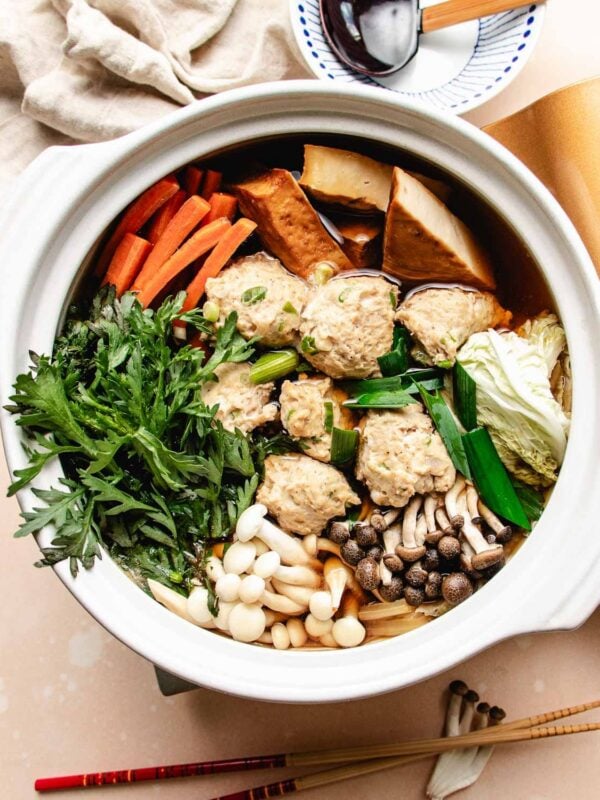
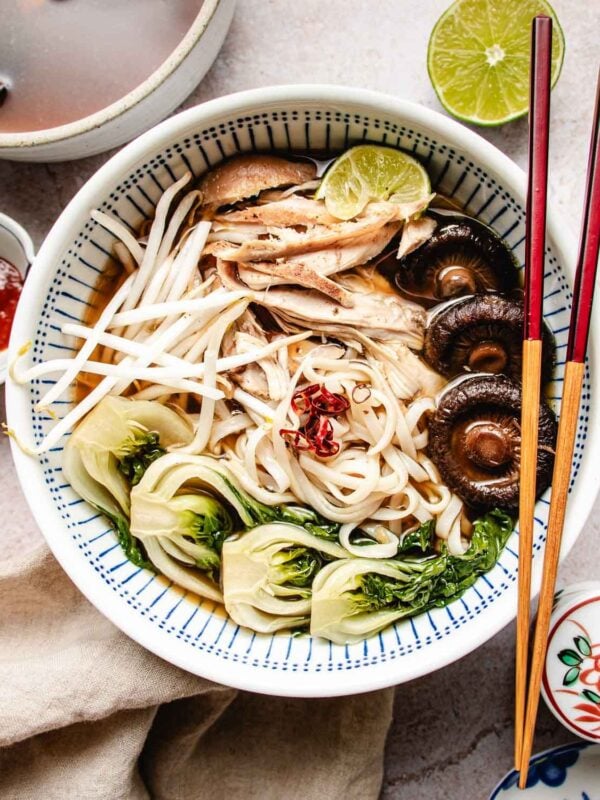











Looks really appetizing. Imma try this. Just need to save up enough.
I can’t have soy. Is there a soy-free substitute for Doubanjiang? Thanks!
Hi Kathy, I listed notes in the recipe card with gluten-free doubanjiang information. Please take a look and hope that helps.
Made this, and it was a huge success! Thank you!
Thank you so much. So happy to hear!
Hi Chih-Yu, I am so glad to have found your website. I tried this recipe and it was incredibly delicious 😋. The only thing I substituted in the recipe is using dates vs. sugar, because I didn’t have sugar in the pantry. No more going to Din Tai Fung for this dish. So wonderful! I have since shared your website with friends ! Thank you so much Chih-Yu!!!
Awww Lina thank you so much! I appreciate your kind words very much. This is my father’s favorite dish so I’m very happy to share. :))
Do you have recommendations or suggestions for a gluten free mild doubanjiang (豆瓣醬)? Thank you.😊
Hi Sandra, great question. So in the recipe, I listed a gluten-free doubanjiang from Japan – Yuki Sichuan Doubanjiang. However, it is quite spicy so I recommend only using it 1-2 tsp only to add depth to the stew. For a lesser spicy (yet still gluten-free), the NPG Black Bean version seems to be milder (based on the user reviews). I have yet to taste this bottle myself but based on the color of the bottle, it does seem less spicy. https://amzn.to/3TvgRf6
This one hits home for me. My mom is from Taiwan and would make this for us when I was a kid. So nostalgic and yummy! Thank you for your amazing recipes!
Aww sweet! I’m so happy to hear!
Wow, this was AWESOME. I was always intimidated by this recipe – i, for some reason, had thought the broth/stew needed to be simmered for hours to taste good. But in under 2 hours, it was amazing!! Thank you for the recipe – I did make some substitutions because I made this on the fly (just happened to have almost the right ingredients):
– yellow onion: used red onion
– cinnamon and ginger: used powdered
– tomatoes: used an 28oz can of diced tomatoes
– shitake: used fresh oyster mushroom (kind and regular small ones)
– dates: used a bit of maple syrup (I assume the dates are in there for sweetness, and not for texture)
– beef stock: used chicken stock
– five spice powder: used garam masala + more allspice/cloves powder
LOL ok… so quite a few substitutions, but it was all I had on hand. it turned out amazing still — and really close the the real thing — yes, i’ve had this dish before in taiwan (perhaps mine had a little more cloves/allspice 😉 in it because i love those flavours)!! Anyway, thank you — and I can’t wait to make this for my parents 🙂 they will love this.
Wow! And you remembered all the details! That’s amazing 😀 Thanks for sharing.
This recipe was FABULOUS. Thank you so much!
So happy to hear, Thanks, Cat!
10/10 recipe. Had zero expectations and was blown away by how rich this broth was. Better than any I’ve ever had in a restaurant! Thanks for this 🙏🏽❤️
Aww so happy to hear! Wonderful you like my family’s recipe! 😀
Great dish! Can I cook this using a pressure cooker?
Thanks, Joseph! Yes I plan on sharing a pressure cooker version soon ! Appreciate it !